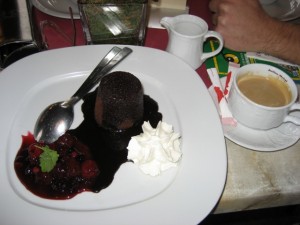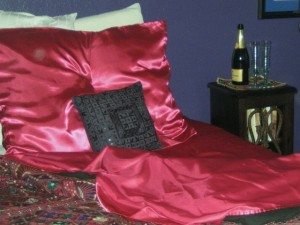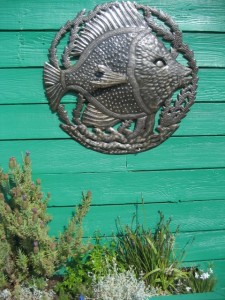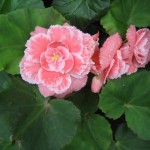A Hedonist’s Guide to Art Acquisition
 This is just my opinion, mind you, and maybe it’s really just me. But I think art acquisition ranks right up there with food and sex in terms of hedonistic drives. Anybody else? So why is that? What triggers that first impulse to buy art? And then what makes us feel compelled to buy more? When does the act of purchasing a single piece of art become a full-on libertine pursuit? And if we are so driven, how do we pursue it as gourmands, and not gluttons?
This is just my opinion, mind you, and maybe it’s really just me. But I think art acquisition ranks right up there with food and sex in terms of hedonistic drives. Anybody else? So why is that? What triggers that first impulse to buy art? And then what makes us feel compelled to buy more? When does the act of purchasing a single piece of art become a full-on libertine pursuit? And if we are so driven, how do we pursue it as gourmands, and not gluttons?![]()

Perhaps the first and most important consideration regarding the purchase of any artwork for collection is its overall aesthetic appeal. The “experts” say that, “A piece of high-caliber art will harmoniously orchestrate the aesthetic ![]() qualities of line, tone, color, shape, space, texture, etc. These elements will work in synchrony to maximize the descriptive, emotive, and spiritual effect upon the viewer. Hence, the piece becomes a visual symphony that informs, challenges, and engages the viewer long after the initial response.” And what, in blue blazes does that mean? Taken down to their most basic form, these criteria are the heart of any decision for purchase. Simply put: “Do I like it? Is it pleasing to me?” If the answer is yes, the piece has potential.
qualities of line, tone, color, shape, space, texture, etc. These elements will work in synchrony to maximize the descriptive, emotive, and spiritual effect upon the viewer. Hence, the piece becomes a visual symphony that informs, challenges, and engages the viewer long after the initial response.” And what, in blue blazes does that mean? Taken down to their most basic form, these criteria are the heart of any decision for purchase. Simply put: “Do I like it? Is it pleasing to me?” If the answer is yes, the piece has potential.
![5596[2]](https://blog.itscactus.com/wp-content/uploads/2012/08/559625-156x300.jpg)
One of a kind piece by Michee Ramil Remy. Over his lifetime, Michee produced a large body of work, receiving numerous awards and international accolades. His style is instantly recognizeable, uniquely primative and somewhat edgy.
By all means, visit art galleries and museums, too. Join art societies and mingle with other collectors and experts in your area of interest. (The Haitian Art Society might be one for you. www.haitianartsociety.com) Check out books and other references, explore every avenue open to you. The more you learn and develop your eye, the better you will become in assessing aesthetic components and their relation to the whole. When you become familiar with the best examples of a particular type of art, you’ll know how your potential acquisition stacks up.
The corollary to this is: Buy the finest artwork that you can afford. Let’s break that down. “Buy the finest…” Certainly! Buying something that is “pretty good” that you “kind of like” won’t give you pleasure in the long run. You’ll end up wishing you hadn’t settled and the piece will not take its place amongst your treasured collection, it will end up in a garage sale. The second part, “…that you can afford,” is good common sense. Don’t break the bank. Not even if you are tempted. That won’t give you pleasure in the long run either.
And we are back to the original idea. Do you like it? Does it give you pleasure? For that is the joy of collecting; to look at your pieces, remembering the where and the when, the knowledge gained, deal struck, and the thrill of the hunt. Oh yes, there can be more to it than pleasure. Much more. But that is where it starts.

![sm413[1]](https://blog.itscactus.com/wp-content/uploads/2012/08/sm41311-133x300.jpg) When a sculpture is selected to be sold in the Beyond Borders catalogue or on our website, we photograph it, give it an inventory number, and a name. This one, for what may be obvious reasons, we chose to name “Double Trouble.” The impish looks on these faces, the hair standing on end, the shape of the mouths – all of that said, “Uh-oh” to us. “Double Trouble,” absolutely. It’s cute, it’s catchy. Maybe someone with twins will buy it.
When a sculpture is selected to be sold in the Beyond Borders catalogue or on our website, we photograph it, give it an inventory number, and a name. This one, for what may be obvious reasons, we chose to name “Double Trouble.” The impish looks on these faces, the hair standing on end, the shape of the mouths – all of that said, “Uh-oh” to us. “Double Trouble,” absolutely. It’s cute, it’s catchy. Maybe someone with twins will buy it.![image005(231)[1]](https://blog.itscactus.com/wp-content/uploads/2012/08/image0052311-220x300.jpg)
![images[1]](https://blog.itscactus.com/wp-content/uploads/2012/08/images1.jpg) They successfully grafted the leg of a recently dead black man onto a disabled white man, who was thus able to walk again.
They successfully grafted the leg of a recently dead black man onto a disabled white man, who was thus able to walk again. Summertime is vacation time for many of us, and as my family lives in a place to which people escape winter’s wrath, it’s probably no surprise that we chose to migrate northward as the summer’s heat became too intense for general tolerance. We set off for Victoria, British Columbia but, of all things, by the second day there, I was reminded of Haiti.
Summertime is vacation time for many of us, and as my family lives in a place to which people escape winter’s wrath, it’s probably no surprise that we chose to migrate northward as the summer’s heat became too intense for general tolerance. We set off for Victoria, British Columbia but, of all things, by the second day there, I was reminded of Haiti. I thought how pleased he would be to see his art so perfectly set in this beautiful place. It tickled me later when I re-read the letter he wrote to Beyond Borders accompanying a sample of this very design. He said, “I take this moment extraordinary to introduce to you my model of fish. I think you and your friends are going to like it very much.” He was so right! Haitian art is as perfectly at home at the beach on the Caribbean Sea as it is along the Straits of San Juan in the North Pacific.
I thought how pleased he would be to see his art so perfectly set in this beautiful place. It tickled me later when I re-read the letter he wrote to Beyond Borders accompanying a sample of this very design. He said, “I take this moment extraordinary to introduce to you my model of fish. I think you and your friends are going to like it very much.” He was so right! Haitian art is as perfectly at home at the beach on the Caribbean Sea as it is along the Straits of San Juan in the North Pacific.
![sm421[1]](https://blog.itscactus.com/wp-content/uploads/2012/08/sm4211-150x150.jpg) And I thought again of Haitian sculptors, this time, Jimmy Prophet and Willie Juiene, whose artful eyes and exacting hands re-fashion Nature’s work so elegantly in steel. The monochrome of the metal they work focusses one’s attention to form and line, and emphasizes the refined precision of the artists’ touch. These men have never seen Buchart Gardens nor are they likely
And I thought again of Haitian sculptors, this time, Jimmy Prophet and Willie Juiene, whose artful eyes and exacting hands re-fashion Nature’s work so elegantly in steel. The monochrome of the metal they work focusses one’s attention to form and line, and emphasizes the refined precision of the artists’ touch. These men have never seen Buchart Gardens nor are they likely  to, but flowers and trees that serve as
to, but flowers and trees that serve as ![2175[1]](https://blog.itscactus.com/wp-content/uploads/2012/08/21751-150x150.jpg) their inspiration are miracles of design no matter where they bloom and flourish. In Haiti, as in Canada, the miracle is the same.
their inspiration are miracles of design no matter where they bloom and flourish. In Haiti, as in Canada, the miracle is the same.![images[4]](https://blog.itscactus.com/wp-content/uploads/2012/08/images4.jpg) Poor countries have a generally have tough time in Olympic competition. There are exceptions, of course, but the powerhouses generally are big countries with big populations and big budgets for international athletics. In this year’s Olympics, it is not surprising that the greatest number of medals is currently around the necks of athletes from United States and China. Yet the athletes of smaller countries compete fiercely and with pride, doing their best to bring honor and glory to their respective homelands in the name of sport.
Poor countries have a generally have tough time in Olympic competition. There are exceptions, of course, but the powerhouses generally are big countries with big populations and big budgets for international athletics. In this year’s Olympics, it is not surprising that the greatest number of medals is currently around the necks of athletes from United States and China. Yet the athletes of smaller countries compete fiercely and with pride, doing their best to bring honor and glory to their respective homelands in the name of sport.![2487[1]](https://blog.itscactus.com/wp-content/uploads/2012/08/248711-300x155.jpg)